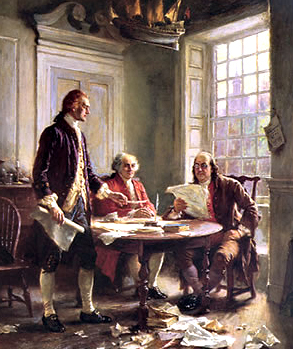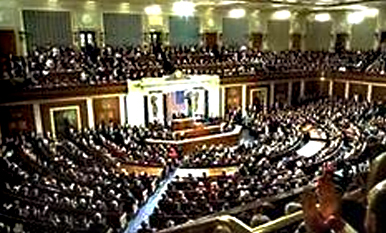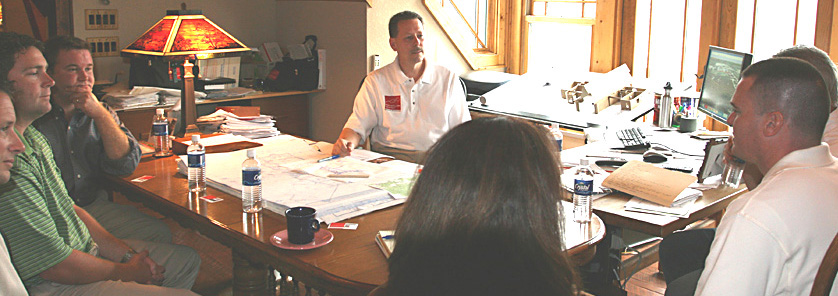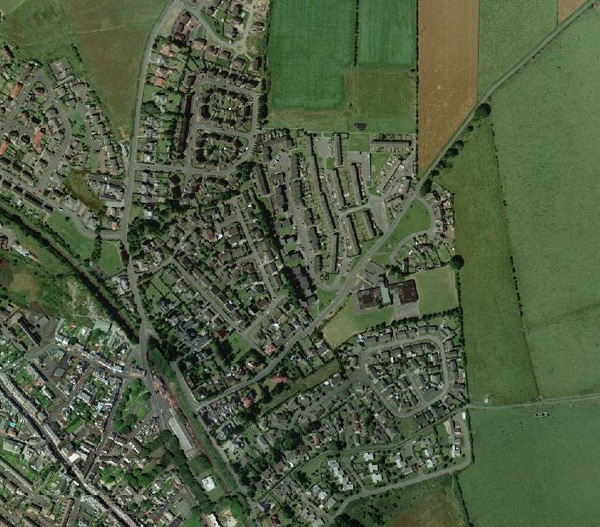© Copyright 2013, Home Architect, PLLC, All Rights Reserved Worldwide. Rand Soellner, ArCH, NCARB, LHI, Senior Staff Architect.
How can this be? The design of how our houses are grouped, laid out and arranged with respect to adjacent residences can fix our broken government? Sounds impossible. What does one have to do with the other? Read on to find out…
Nearly every government on Earth is flawed. They all succumb to corruption, vested interests, splinter coalitions and lack of ability to agree that the sky is blue, much less the important matters of the day, month, year, decade or century. Why? Why do governments fail? Take for instance, the most successful and powerful county on the planet: the United States. There is gridlock in Washington. Nothing is getting done. Why is this?
There is a simple answer: there are too many people trying to decide the issues.
That’s it. There are 100 senators and 535 congresspeople. It is almost impossible to get any group of people to agree on anything, much less, this many: 635 people. Do we have adequate representation from all states? It would appear so. That is not the problem.
SOME HISTORY OF HOW WE GOT TO WHERE WE ARE

However, one wonders if representation in the 21st Century might not be more homogenous throughout the USA, based on changes in our economy, laws and attitudes, than they were in 1776? 237 years ago, there were only 13 states, and much of what the USA was becoming was based strongly on statehood boundaries and each state was markedly different back then in economy, social policy, gender and racial equality, and industrial needs and resources to support a growing country that needed to become unified. Now, we are unified: we are one country. That task was accomplished as of 1869, and during the subsequent decades, while those that fought the battles dwindled and died and new generations moved to other parts of America, blending us all together. We are now all Americans.
Now, our Country has been built. Back then, it was still being organized. We are still governing ourselves within the same framework that was conceived while fighting for our independence and our very lives. It is primarily based on representation of states, not necessarily representation of individuals. So how would an improved form of government be organized to offer better representation of individuals, based on the very fabric of new communities? Of how humans organize themselves into social groupings to solve their problems and improve their situations? Sounds impossible. And wouldn’t this be a structural change in the government of the USA? How would that ever be accomplished? Would those 635 people and a President really work together to change how they conduct business as usual? Or rather, not conduct much of any business at all, given today’s sad performance record.

We all might wish to blame certain people: certain senators, presidents and congresspeople, and sure, many of them should be blamed, however, many of them should be applauded.
They are just people, trying to do what they believe is a good job. Pity them, rather, because they are trying to accomplish what they feel are good and worthy things, within a framework that is broken. The current system insures that any efforts, no matter how well-intentioned, will be met with vehement opposition, to result in the accomplishment of next to nothing. “Full of sound and fury and signifying nothing,” to quote Shakespeare. Is this a criticism of the USA? No, absolutely not! America is amazing: having accomplished so much, despite such a socially flawed governmental structure for today’s times. The thought is: could things be improved? Perhaps. Consider the following:
If we now reflect on discoveries made during the last couple of centuries in social psychology and how people effectively work together to accomplish useful things, we may be able to shed light on perhaps an evolved manner of organizing our communities, villages, towns and cities. This may suggest a better means of establishing agreements amongst ourselves to result in an improved representational government, directly related to urban planning and community design: how we organize our homes with respect to other houses.
BEST SIZE GROUP OF PEOPLE TO ACCOMPLISH MEANINGFUL THINGS
(continued below):
What do all of these words mean? What are we talking about? Let’s start with several obvious successful examples of the NUMBER of people that are able to work together effectively. Interesting question, isn’t it? How many people is the RIGHT number of people to make important decisions and to effectively work together and to constructively coordinate with each other to accomplish meaningful goals? Does anyone know?
Yes. They do. Social psychologists, dating back into the 1960s and 1970s discovered things that have been staring all of us in the face for a very long time. Once you see what you are about to read, the veil will be lifted and you will be peering into the reality of human sociology, which is all around you. Here we go:
Number of people Task/Group
12 max, 10 min Jury (criminal)
10.3+/_ Corporate Board of Directors (source: Moody’s Index)
9 Baseball team (on the field)
11 Football team (on the field)
5-25 Al-Anon groups
11 Soccer team (on the field)
5-12 Wharton Graduate Leadership Program, Evan Wittenburg, Dir.(regarding effective social group size)
8-15 Various leading social psychologists’ research (regarding effective social group size)
5-12 Study of online groups and Dunbar by C. Allen
4-9 R.I.M. Dunbar & Duncan, Clique size study in
“Coevolution of Neocortical size, group size and language in
humans,” Behavioral and Brain Sciences, 1993.
7.1 Congressional Subcommittee (James, 1952)
5.5 State & City Board committees (James, 1952)
And there are countless other studies reinforcing the above. What the numbers above start to suggest, especially the Moody’s study, conducted by this author, personally, while in the graduate study program at the University of Florida, is that it takes a minimum of about 5 people and a maximum of about 15 people to create a group of people that have enough points of view to have worthwhile views, but not too many people, because social psychologists have discovered that somewhere between about 9 to 15 people, splinter coalitions begin to form, which damage the social cohesion of the effectiveness of the group.

This author came to the conclusion, during an urban design course in which students were tasked with designing an entire city, that 7 to 12 was the core-group “best” size for a group of people to discuss various topics and establish ways and means of deciding the options and then deciding and recommending the best course of action and policy. It is interesting that the US Congress seems to understand this, as their own subcommittee group size is around 7.1+/-. The problem is that Congress and the Senate have no hierarchical mechanism to take the recommendations from such effective subgroups and then implement and apply them to the organization as a whole. This author’s thought is that our lawmakers’ subcommittees probably work very well. The Senate probably has similar subgroups. And WHY do they break down into these subgroups? Because, on some basic, core understanding of how useful things get done, they KNOW that it will take a smaller group of people, numbering far less than the entire Congress or Senate. The problem is: how to then apply the good work of these various committees to the organization at large. That is probably a topic best left to political scientists. Below you will find an architectural and urban design suggestion that might lead in a worthwhile direction for new community design, with far-reaching implications.
NEW DIRECTIONS FOR COMMUNITY NEIGHBORHOOD DESIGNS
What does all the above have to do with the design of houses and how they are grouped together in a neighborhood community?
Here is the answer:
BECAUSE THE ARRANGEMENT OF THIS INITIAL, MOST BASIC CORE GROUP OF HOUSING IS THE “ATOM” : THE BUILDING BLOCK FOR AN ENTIRE CITY, COUNTY, STATE AND NATION.

In other words, when designing and planning a neighborhood, consider:
arrange from 7 to 11 homes around some sort of central area, which serves as a social meeting location and vehicular and pedestrian circulation hub for everyone, if they wish to have interaction. Great idea for allowing people to meet their neighbors and discuss matters of interest and importance to them. This is the core of grassroots. These people are the individual blades of grass that make up our nation’s lawns and rolling plains from North Carolina to California and Minnesota to Texas.
While we are at it, let’s not be short-sighted in terms of the environment. If we are going to create some architectural and urban planning geometry from the 7 to 11 home grouping (let’s call it a Neighborhood “Cluster”), let’s not forget to have at least one open facet in which to connect with the environment: the great Outdoors. In other words, in plan view: an octagon (8 sides) or a dodecagon (12 sided polygon), or a circle or square or rectangle, with a missing, unbuilt, open slice for a Nature connection, might make some sense, if we are talking about a green-field site. You build homes on the 7 parts of the octagon Cluster and likewise build homes on the 11 parts of the dodecagon Cluster, in each case, leaving at least one slice open for access to nature and open space connection to the greater community. Not to mention that the the core social & circulation area should have some natural features, in addition to necessary functional elements.
This is the “atom”, discussed above. With this neighborhood Cluster concept, you can do the following:
HOW TO REBUILD A NATION WITH THE CLUSTER CONCEPT
Now that you have a Cluster, what do you do with it? Well, if you are building an entirely new community, village, town, city, state or nation, you can do this:
1. Build 7 to 11 Clusters, each with an entirely open space in the octagon or dodecagon, for connection to nature and to create parks within the fabric of the community and between adjacent community clusters.
Let’s call this larger grouping of Clusters the Hamlet.
2. Build 7 to 11 Hamlets, using the same principles as before (including reserving natural space between the Hamlets).
Let’s call this larger grouping a Village.
3. Build 7 to 11 Villages, using similar principles (including natural space between each Village).
Let’s call this a Town.
4. Build 7 to 11 Towns. Let’s call this the City. Include previous land use principles.
5. Build 7 to 11 Cities. Let’s call this a County. Include previous land use principles.
6. Build 7 to 11 Counties. Let’s call this a Countyship. Include previous land use principles.
7. Build 7 to 11 Countyships. Let’s call this a State. Include previous land use principles.
8. Build 7 to 11 States. Let’s call this a Region. Include previous land use principles.
9. Building 7 to 11 Regions. Let’s call this a Nation. Include previous land use principles.
Now we have entirely rebuilt the US of A, in theory. That won’t happen in a day, week, month, decade or even a century. But in time, a focused effort to replace our aging infrastructure and aging homes, urban areas and aging political methods of obtaining consensus could evolve into something that might work better.
Notice how, for instance, that at each stage of development, that each Cluster, Hamlet, Village, Town, City, County, Countyship, State, Region and Nation has a growing connection to the environment and natural areas of scenic beauty. This is something not done before, which is part of the reason that we are now having to backtrack and provide for this before we have serious consequences. Better to build this into our new fabric of development, so that it is on auto-pilot. Of course, all existing park reserve systems would be maintained, integrated and expanded in the rebuild.
THE EVOLVED AND IMPROVED DECISION-MAKING GOVERNMENT AS A FUNCTION OF NEW COMMUNITY DESIGN ARRANGEMENT
But wait a minute! What about the whole concept of improving how government works through community design? Where is that in all of this?
It is right there, built into the fabric of the Clusters and Hamlets and other escalating groupings. Where? There: in the Cluster and in the numbers of houses in each.
Here’s how:
Cluster Representation:
the 7 to 11 households in each Cluster have 1 vote. They elect a Cluster Representative. Notice how the number (7-11) works well for making decisions: there should rarely be a tie-vote: decisions will be made. The number of homes should always be an odd number. The Cluster Representative is charged with the responsibility to manage their Cluster’s needs and to convey his or her Cluster’s desires and needs and hopes to the next level of true representational grassroots government (in addition to coordinating with the household people of this Cluster) :
Hamlet Representation:
the 7 to 11 Cluster Representatives in each Hamlet have 1 vote. They elect a Hamlet Representative. That representative is charged with the responsibility to manage their Hamlet’s needs and to convey his or her Hamlet’s desires and needs and hopes to the next level of government (in addition to coordinating with the Cluster Representatives for this Hamlet) :
Village Representation:
the 7 to 11 Hamlet Representatives in each Village have 1 vote. They elect a Village Representative. That representative is charged with the responsibility to manage their Village’s needs and to convey his or her Village’s desires and needs and hopes to the next level of government (in addition to coordinating with the Hamlet Representatives for this Village):
Town Representation:
the 7 to 11 Village Representatives in each Town have 1 vote. They elect a Town Representative. That representative is charged with the responsibility to manage their Town’s needs and to convey his or her Town’s desires and needs and hopes to the next level of government (in addition to coordinating with the Village Representatives for this Town):
City Representation:
the 7 to 11 Town Representatives in each City have 1 vote. They elect a City Representative (Let’s call that person a Mayor). The Mayor is charged with the responsibility to manage their City’s needs and to convey his or her City’s desires and needs and hopes to the next level of government (in addition to coordinating with the Town Representatives for this City) :
County Representation:
the 7 to 11 City Representatives in each County have 1 vote. They elect a County Representative (Let’s call this person a County Commissioner). The County Commissioner is charged with the responsibility to manage their County’s needs and to convey his or her County’s desires and needs and hopes to the next level of government (in addition to coordinating with the City Representatives from this County) :
Countyship Representation:
the 7 to 11 County Representatives in each Countyship have 1 vote. They elect a Countyship Representative. That representative is charged with the responsibility to manage their Countyship’s needs and to convey his or her Countyship’s desires and needs and hopes to the next level of government (in addition to coordinating with the County Representatives from this Countyship) :
State Representation:
the 7 to 11 Countyship Representatives in each State have 1 vote. They elect a State Representative (Let’s call that person the Governor of that State). All of the people in that State also may vote for the Governor, to verify that the right person is elected. That representative is charged with the responsibility to manage their State’s needs and to convey his or her State’s desires and needs and hopes to the next level of government (in addition to coordinating with the Countyship Representatives from this State) :
Region Representation:
the 7 to 11 State Representatives in each Region have 1 vote. They elect a Region Representative. That representative is charged with the responsibility to manage their Region’s needs and to convey his or her Region’s desires and needs and hopes to the next level of government (in addition to coordinating with the State Representatives from this Region) :
Nation Representation:
the 7 to 11 Region Representatives in the Nation each have 1 vote. They elect a Nation Representative (let’s call this person the President) and their vote for this person is also voted upon by all of the people in the entire nation and the votes compared, to insure that the person best represented everyone’s interests is elected. That representative (the President) is charged with the responsibility to act on behalf of the entire citizenry of the Nation, in conjunction with the Region Representatives. The Region Representatives, all 7 to 11 of them, are tasked with the issues that today’s present 635 lawmakers are (today’s current Senate and Congress) on the National level.
So: we have effectively whittled down the 635 person national decision-making Senate and House to 7 to 11 people, all the duly elected representatives of the Nation, starting with the Cluster Representatives, going back to each household. No doubt such a trimmed governmental body would speed decisions and dramatically reduce the cost of government. No more junkets at taxpayers’ expense. No more filibusters. No more indecision and splinter partisan politics. You vote for a person, not for a Party. Each person is directly responsible to the body of people that voted for him/her, all the way back to each Cluster Representative. And all of those fancy Washington buildings can be rented by the Government to private businesses, resulting in some useful income from all of that real estate, to help America’s taxpayers.
And what allowed this to happen? The redesign of the “atom” in our country: the redesign of housing groupings into a more meaningful and enriching social arrangement, that also has the added benefit of an improved environmental connection, woven into its very fabric, at multiple levels.
This has been an exercise in theory and urban design, with coordinated neighborhood community design. Reshaping America in this model would probably take as long as America has been a country: perhaps two hundred years, IF enough people could agree to rethink how we go about living and governing ourselves. It doesn’t hurt to dream…
If you are visionary developer and would like to see how you might help bring one of these Clusters to life, or perhaps even more, please contact:
Rand@HomeArchitects.com
tags: social community design can fix government, housing design of clusters, new city organization, natural connection to urban arrangements
